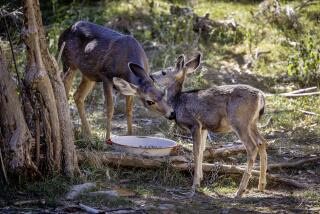Reservoir Low : Edison Will Seed Clouds on Catalina
Cloud-seeding to increase rainfall on Santa Catalina Island will begin this month, as airplanes sprinkle dry ice into the clouds over the island, Southern California Edison Co. officials said Friday.
The program will begin around Dec. 15, when the Fresno-based firm Atmospherics Inc. will start monitoring Catalina’s weather to determine optimum times for sending up a pilot to induce or increase rainfall, said Keith LeFever, Edison’s district manager for the island.
The program is intended to increase the amount of water in the Middle Ranch Reservoir, the island’s major water source, which has been significantly lowered after four straight years of less-than-average rainfall and an increase in water use during the last two years, LeFever said.
From 1984 to 1987, rainfall on the island averaged just over 7 inches a year, LeFever said. More important, the island had no rainstorms that lasted more than a day, which would have allowed runoff from the rain to accumulate in the reservoir, he said. Average annual rainfall since 1970 has been about 12 inches.
“We’re not alarmed at all over the water levels,” LeFever said. “We’re concerned because impoundment is lower than it has been in the past 10 years.”
This will be the third cloud-seeding program on Catalina, LeFever said. Previous programs were during the 1977-78 rainy season, when an average of 26 inches of rain fell in a 12-month period, and in 1982-83, when rainfall was just over 25 inches, he said.
“Both times, it increased significant enough to warrant spending the money” on a third program, LeFever said. The previous programs cost around $50,000 each, but the bill for the latest program will depend on how many times the clouds are seeded, he said.
And as rain has decreased, water consumption has increased, he said.
“In the last two years we’ve had less than average rainfall, and at the same time, we’ve had the highest-recorded consumption on record as far as water sales are concerned,” LeFever said.
Consumption has averaged about 380 acre-feet over the last 10 years, but in 1987 the figure reached 460 acre-feet, and the same is expected for this year. An acre-foot is 326,000 gallons.
Atmospherics Inc. President Tom Henderson said Catalina Island is a good candidate for cloud-seeding because its altitude “has a tendency to push the air up over the island and help make the clouds larger, which in turn makes them better candidates for seeding.”
Although the pilot will target areas over the Middle Ranch Reservoir, the effects of any increased rainfall would likely be felt all over the island, Henderson said.
The possibility of flooding is slight because rainfall is usually increased by 10% to 20%, not enough to cause flooding, Henderson said.
Cloud-seeding typically takes place on inclement days when larger clouds are likely to form. During seeding, a pilot drops pellets of silver iodide or dry ice into a cloud, forming ice crystals that turn into rain as they grow heavier and fall to the warmer atmosphere closer to Earth.
In the Catalina cloud-seeding program, Atmospherics Inc. will use dry ice instead of silver iodide because with dry ice it is easier to induce rain in a targeted area, Henderson said. The flights will be from Long Beach Airport in a specially equipped, turbocharged plane.
HOW CLOUDS ARE SEEDED
All air contains moisture--water vapor; the measure of moisture is called relative humidity. As air cools, humidity increases and cloud droplets form around microscopic particles of dust, smoke, salt crystals and other materials naturally present in the atmosphere. Clouds are made up of billions of these water droplets or ice crystals. Cloud-seeding--first tried in 1946--is intentional treatment of individual clouds to boost or alter precipitation from hail to rain. Cloud-seeding does not make it rain; it is a process aimed at increasing rainfall in a cloud ready to rain.
1. Clouds form when warm, moist air near the Earth’s surface lifts and cools to the point where water vapor condenses into liquid droplets so small that it may take more than a million to produce a single raindrop. Lifting of air masses can be induced by the heat of the sun or by passage of warm or cold weather fronts.
2. As the cloud grows it is seeded with silver iodide or dry ice. The object is to increase the number of ice crystals in the supercooled portion of the cloud. Generally the taller the cloud, the cooler it will get. Seeding can affect the dimensions of the cloud, its lifetime or the size and concentration of droplets or ice particles.
3. When surrounded by supercooled liquid droplets, ice crystals grow rapidly until they are heavy enough to fall through the cloud, melting into raindrops on the way down. The silver concentration in rainwater after cloud-seeding is far below levels set by the Public Health Service and the iodine is far less than that found in table salt.
4. Much more water is processed by the enlarged cloud, resulting in more and longer rainfall before the cloud dissipates. When silver iodide causes liquid droplets to freeze, a large amount of heat within the cloud is released. The cloud is kept buoyant and processes 10% to 25% more water over a long period of time.
Source: Atmospherics Inc., Fresno
More to Read
Sign up for Essential California
The most important California stories and recommendations in your inbox every morning.
You may occasionally receive promotional content from the Los Angeles Times.










